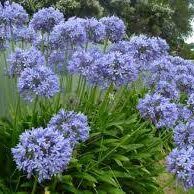Mastering the Art of Agapanthus Treatment: Important Steps for Healthy Development and Dynamic Flowers
In the world of gardening, the cultivation of agapanthus stands as a gratifying venture for those who look for to nurture these stylish blooming plants. From picking the ideal variety to mastering pruning methods, the journey in the direction of cultivating thriving agapanthus plants is diverse and holds the key to unlocking the complete capacity of these herb treasures.

Choosing the Right Agapanthus Range

When selecting the ideal Agapanthus selection for your garden, take into consideration elements such as climate suitability, blossom color, and development routine. Additionally, take into consideration the environment in your region to make certain the Agapanthus selection you choose can flourish in your details conditions. Recognizing the growth habit of different Agapanthus ranges is essential for correct positioning within your yard.
Perfect Growing Problems
Taking into consideration the optimal ecological needs is important for effective Agapanthus farming. Agapanthus plants are sensitive to chilly temperature levels and should be protected from frost during winter months.
To guarantee healthy and balanced growth and vivid blossoms, plant Agapanthus bulbs at a deepness of about 2-4 inches and space them 8-12 inches apart. Adding raw material, such as garden compost, to the dirt can enhance drainage and fertility, advertising durable origin growth. Mulching around the base of the plants aids keep dampness and suppresses weed development. Routine watering is crucial, particularly throughout the growing season, to keep the dirt consistently damp however not waterlogged.
Watering and Fertilizing Tips
Preserving proper dampness levels and offering necessary nutrients are vital elements in the treatment routine for Agapanthus plants. When it comes to watering Agapanthus, it is vital to strike a balance. These plants like regularly moist dirt however are vulnerable to root rot if overwatered.
Feeding Agapanthus is essential for promoting healthy growth and respected flowers. Apply a balanced plant food, such as a 10-10-10 formula, in the very early springtime as brand-new growth arises. By complying with these watering and feeding pointers, you can guarantee your Agapanthus plants flourish and create vibrant, resilient blossoms.
Trimming Techniques for Agapanthus
Pruning Agapanthus plants at the appropriate times and with proper techniques is critical for preserving their health and wellness and advertising ideal development and blooming. The optimal time to trim Agapanthus remains in late winter or very early spring prior to new growth arises. you can check here Begin by removing any type of dead or yellowing leaves near the base of the plant. Cut them as short as possible without harming the arising shoots.
For flowered stems, wait till the flowers have actually withered and afterwards trim them back to the base. This not only cleans up the plant's look yet also urges the growth of new flower buds. Deadheading invested flowers can additionally reroute the plant's energy right into producing more flowers as opposed to establishing seeds. Nonetheless, if you intend to collect seeds for proliferation, leave some flowers to mature and dry on the plant.
Bear in mind to make use of clean, sharp tools to make accurate cuts and lower the danger of presenting diseases. Agapanthus. Regular trimming will certainly assist maintain your Agapanthus looking neat and visit this page healthy while making certain a plentiful screen of beautiful flowers
Managing Usual Parasites and Diseases
After ensuring appropriate pruning methods for Agapanthus, it is necessary to attend to typical pests and conditions that can affect the health from this source and wellness and vigor of these plants. One typical insect that influences Agapanthus is the Agapanthus gall midge.
One more usual issue is fungal fallen leave area, which provides as dark lesions on the fallen leaves. To stop fungal conditions, make certain good air blood circulation around the plants, prevent above watering, and eliminate any contaminated leaves without delay. Furthermore, Agapanthus plants can experience origin rot if they are planted in poorly draining pipes soil. To stop this, plant Agapanthus in well-draining dirt and prevent overwatering. By being attentive and taking punctual action against insects and illness, you can help your Agapanthus plants grow and create dynamic blossoms.

Conclusion
To conclude, mastering the art of agapanthus care entails choosing the right range, offering perfect planting conditions, proper watering and feeding, ideal pruning strategies, and dealing with common insects and illness. By following these important actions, you can guarantee healthy and balanced development and lively blossoms for your agapanthus plants. Keep in mind to regularly monitor and maintain your plants to advertise their overall health and long life.
To make sure healthy growth and dynamic blossoms, plant Agapanthus bulbs at a deepness of regarding 2-4 inches and space them 8-12 inches apart. By adhering to these watering and feeding tips, you can ensure your Agapanthus plants grow and create vivid, long-lasting blooms.
One common parasite that influences Agapanthus is the Agapanthus gall midge. In addition, Agapanthus plants can suffer from origin rot if they are grown in inadequately draining pipes soil. By following these important steps, you can guarantee healthy and balanced growth and vivid flowers for your agapanthus plants.